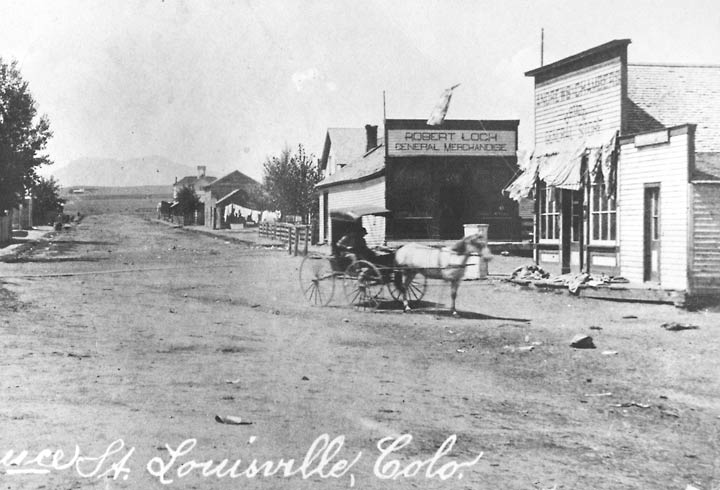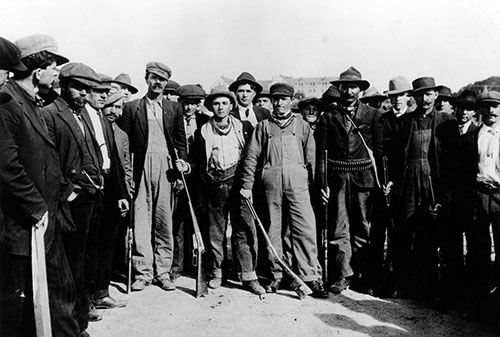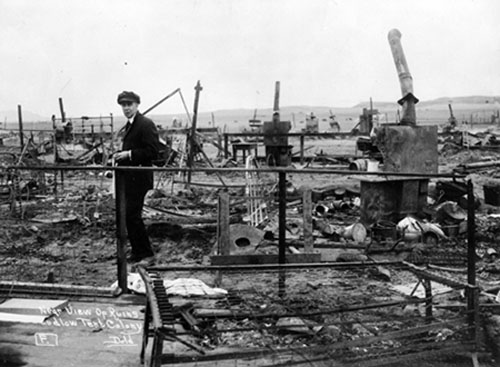The Louisville Historian
Winter 2014
by Ron Buffo

The discovery of massive coal deposits in Colorado beginning in the 1860s combined with the increased need for energy resources to fuel the industrial juggernaut of the United States created an opportunity for incredible economic growth. In order to utilize the subterranean energy, large numbers of workers were necessary to extract the coal and, beginning in the 1880s, the immigration of foreign laborers was encouraged and made real. Early immigration (1840-1860) brought people from Northern Europe and later immigration (1860-1890) added Southern and Eastern European countries as major contributors to the workforce in the United States. Colorado miners in the Southern fields worked primarily for the Colorado Fuel and Iron (CF&I) company owned by John D. Rockefeller whereas miners in the Northern fields worked for a variety of operators. The most prominent company in the Northern fields was the Rocky Mountain Fuel Company owned by John Roche. What the owners had in common was their great dislike of labor unions (particularly the United Mine Workers of America) and their concerted effort to stop any organizing or influence attempted by the unions. Giving in to the demands of organized labor such as increased pay, shorter work days and weeks, better safety conditions, and a check weigh man from the ranks of the workers only decreased the profits of the company. By 1910 the UMWA, after years of trying to negotiate with the coal companies in Northern and Southern Colorado, declared a strike in the Northern fields prompting the walkout of over 3,000 miners. The Southern fields would follow in 1913. (Following the strike declaration, mine owners proceeded to fence off the mine properties, install searchlights and machine guns on towers, hire professional detective agencies to secure the compounds, and provide onsite living accommodations for the strikebreakers and their families.)

After the 1910 strike declaration there would be four years of animosity, hatred, and violence between striking miners and mine operators, strikebreakers, Colorado National Guard (also known as the Militia), and detective agencies. The Ludlow Massacre on Monday, April 20, 1914 and the news of the deaths of four children and eleven women at the hands of the Colorado Militia helped to incite the Northern Field miners. Along with the three previous years of tension with the Baldwin-Felts Detective Agency the Northern Fields were ripe for violence. An explosive mixture was made up of spotlights shining into town at all hours of the night, armed detectives walking the streets of Louisville and Lafayette, gunfire being exchanged between the Hecla Compound and town, and the ever present “scabs” and their families. (The location of the Hecla was at the present location of the Louisville King Soopers at 1375 E. South Boulder Rd.) The most objective account we have of the events in Louisville leading up to and including April 27th, 1914 comes from the deposition of Boulder County Sheriff Sanford D. Buster. He had been Sheriff since January 1913, was well aware of the explosive situation in the coalfields in his jurisdiction, and was compelled to be fair-handed with the strikers and coal mine operators alike. Buster’s deposition shows a chronology of events beginning on Thursday the 23rd with his visit to the Gorham Mine in Marshall to investigate armed strikers where he found “a house full of men armed with rifles.” They said they were getting ready to defend themselves against “scabs” who were bent on killing them. From Marshall, Sheriff Buster went to nearby Superior, back to Marshall, and finally arrived in Boulder on Friday, April 24th at 2:15 a.m. Upon his arrival in Boulder, Buster was informed that shots were fired at the Gorham Mine so he quickly went back to Marshall but was not successful in finding the culprits. Buster went back and forth all Friday night the 24th and Saturday the 25th between Louisville, Marshall, and Superior in an attempt to stop potential violence.

The Sheriff continued his diligent appraisal of the communities at the request of Governor Ammons and District Attorney George Carlson of the 8th Judicial District. (Carlson would win the election for Governor in November of 1914.) On Monday the 27th Buster received a phone message from Carlson telling him that the mine operators and the UMWA came to an agreement that turned over control of searchlights and machine guns at the various mine compounds to the Sheriff. This was an obvious attempt to defuse the tensions and Buster immediately sent deputies to the Mitchell, Gorham, Simpson, and Industrial mines. The Sheriff would personally take over the searchlight and machine gun at the Hecla.
Buster left Boulder at 8:30 p.m. on the 27th and arrived at the Union Hall (just south of present day Blue Parrot Restaurant) at 9:00 p.m. To his amazement he found approximately 400 highly agitated miners and, after explaining the plan to secure the mines with deputies, was met with some agreement but also with a rousing call to arms by Joe Potestio, the local UMWA secretary. 3 Potestio said that this agreement was a ploy by the company to tie up the Sheriff and his men and then shoot up the town without restraint. The meeting ended around 10:00 p.m. and shortly after Buster was informed that there was shooting at the Vulcan mine in Lafayette. Without hesitation the Sheriff told Deputy Ivan Criss, Potestio, and local President Pat Powers that they were to accompany him to the Hecla on foot. Potestio refused to go and Powers was later sent back to call UMWA leaders Edward Doyle and John Lawson. Buster and Criss made their way from the Union Hall to the Louisville Depot and proceeded north on the railroad tracks on their way to the Hecla Compound. What unfolded before their eyes was the appearance of scores of miners running, with rifles, from their houses toward the railroad tracks and firing at the Hecla.

(These .30/.30 repeating rifles had been shipped to Colorado by the Union and handed out to the striking miners. It was a common occurrence in the months leading up to this day for striking miners and detectives who manned the Hecla Mine compound to trade gunfire, usually at night. The spotlight from the mine would be directed towards town for harassment purposes and would be met with gunshots from Louisville. Those families who lived on the northeast border of Louisville proper were forced to sleep in their cellars and some even relocated young children to other families for their protection. Mike Buffo was in his outhouse, located at the corner of South Street and La Farge Avenue, when a bullet from the Hecla penetrated it and creased the top of his hand. For years after the event, houses in town had visible bullet holes in their siding. Additionally, it was common practice for passengers on the Interurban train going to and from Boulder through Louisville to be ordered to lie on the floors of the train to avoid being shot during the random firefights taking place.) The Sheriff and his Deputy had made it half way to the Hecla when they were forced to head northeast across the field to the house of town marshal Al McDonald. Buster and Deputy Criss left McDonald’s house and proceeded northeast to the Hecla compound and, unfortunately, were caught in the crossfire between the striking miners in town and company detectives in the mine. The two men had to take refuge in a nearby house and were pinned down by the continuous gunfire until 3:30 a.m. when there was a lull in the action. From the house Buster was able to call the Hecla compound to ask them not to shoot into town and that he was coming to the mine. During this time striking miners had taken positions in an empty ditch bordering the north side of the mine site using it as a defensive trench and, perhaps, a jumping off point to attack the compound. The ditch was flooded by the farmer (Rosenkrantz) through his own initiative or coercion by a command by the compound guards. Three striking miners would be wounded during the “attack” on the Hecla from gunfire directed by Baldwin-Felts guards in the compound.
The gunfire began again at 4:00 a.m. with less intensity and Buster was able to go back and forth between the Rex #1 mine and the Hecla. The shooting stopped between noon and 12:30 on Tuesday the 28th and Buster was able to enter the Hecla compound to assess the damage. Photos show numerous bullet holes in the mine boarding house and company workers’ houses. Thousands of bullets had been expended the previous night and Buster would find two strikebreakers wounded inside the Hecla compound and one strikebreaker dying. Estimates at the time reported that in excess of 25,000 rounds had been fired.

After hearing about the events in Louisville, “concerned” citizens from Boulder made an attempt to recruit armed volunteers to help the Sheriff regain control of the situation. While that did not happen, reaction from the state was immediate with orders from Governor Ammons to send the National Guard from Canon City to Louisville the next day on April 28th. These were the very same soldiers who participated in the violence at Ludlow, so there was great anxiety in Louisville about what could happen here. Outside of Louisville the crew of the train carrying the 128 soldiers refused to continue, so the trainmaster and dispatcher took over. The train was fired upon and the Militia walked the rest of the way to town, marched through town, and encamped at the Hecla. In those first days following the violence, General John Chase, commander of the Colorado National Guard, closed all of the saloons in Louisville and an attempt was made to disarm the miners. Also, additional Colorado Militia members were brought to Louisville from Boulder and Longmont, bringing the total to 250 men. (Company D of the 3rd Colorado Cavalry out of Boulder had the dubious historical distinction of having participated in the Sand Creek Massacre in 1864, although these men in 1914 were far removed from that event.)

On May 3rd, after a request from the Governor, the Twelfth U.S. Cavalry with 158 troops arrived from Fort Robinson, Nebraska and took over security detail from the Colorado Guard to the great relief of the citizens. They were greeted with the local brass band and scores of people from Louisville and Lafayette came out to see the troops who would stay for approximately one year. During that time the military command would confiscate weapons and ammunition and were able to bring a semblance of peace to the surrounding areas. The strike would continue until December 1914 with the result that the miners could return to work but without any of their demands being met. The length of the strike, biased publicity, and popular opinion against them made it difficult for the strikers to make much headway so most were simply happy to get their jobs back. After the Long Strike there would be more labor conflict, wages would slowly increase, working conditions remain extremely dangerous, and miners would continue to die and suffer horrific injuries. (Between 1900 and 1914 an average of 93 men would die in Colorado coal mine accidents per year. In 1910 there were an extraordinary 323 deaths. In 2013 there were 20 deaths in coal mine accidents in the United States.)

Sheriff Sanford Buster showed tremendous courage in dealing with the volatile factions of strikers, detectives, and militia and it is remarkable that he didn’t lose his life when caught in the crossfire on that Monday night in 1914. He tried to remain as neutral as possible within the law and it is likely, had someone else been in his position, there would have been more injuries and loss of life. After being Sheriff for two terms, Buster was Deputy County Assessor and County Commissioner. He died in 1938.
https://www.louisvilleco.gov






